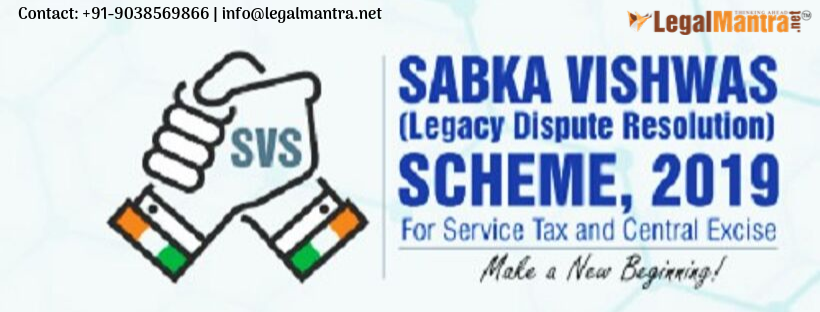View News
Know About Sabka Vishwas (Legacy Dispute Resolution) Scheme, 2019– A Short Write-up

Budget 2019 will always be remembered for Sabka Vishwas (Legacy Dispute Resolution) Scheme, 2019 announced by the Honourable Finance Minister Ms. Nirmala Sitharaman. During the course of statement before the parliament in the budget speech she said and I quote
With an intention to allow business to move on smoothly without litigation, Legacy Dispute Resolution Scheme is launched by the Government which will allow quick closure of the litigations.
It is one of the best schemes so far. The budget documents reads as under:
“141. GST has just completed two years. An area that concerns me is that we have huge pending litigations from pre-GST regime. More than Rs. 3.75lakh crore is blocked in litigations in service tax and excise. There is a need to unload this baggage and allow business to move on. I, therefore, propose, a Legacy Dispute Resolution Scheme that will allow quick closure of these litigations. I would urge the trade and business to avail this opportunity and be free from legacy litigations.”
The Finance Minister further appealed to the trade and industry to come forward and take the advantage of opportunity and be free from legacy litigations.
In the past also, amnesty schemes were introduced by the governments like KVSS- Kar Vivad Samadhan Scheme 1998 or VCES 2013, Voluntary Compliance EncouragementScheme, 2013. However, present Sabka Vishwas (Legacy Dispute Resolution) Scheme, 2019(SVLDRS 2019) is much more refined & better than all other past schemes
Though scheme was announced on 5th July 2019 by the Finance Act No-2, 2019, it was enacted on 1st August 2019, effective from 1st September 2019. Related Rules were notified vide Notification dated 21st August 2019 No. 05/2019 Central Excise-NT
The idea behind the new resolution scheme is
- Release revenue in disputes which is at around Rs. 3.75 lakh crore.
- Remove the numerous litigation at all levels as in Central Excise and Service tax. [Minister of State for Finance Anurag Thakur in a written reply to a question in the Rajya Sabha said the total pendency of appeals at the Supreme Court, High Court and CESTAT (Customs Excise and Service Tax Appellate Tribunal) as on June 30, 2017, was 2,73,591].
The relevant extract of the said report is as below
|
CESTAT BENCHES – PENDENCY STATUS |
|||
|
As on 01.08.2019 |
|||
|
CESTAT BENCHES |
Excise |
Service Tax |
Total |
|
MUMBAI |
5033 |
5030 |
10063 |
|
AHMEDABAD |
5756 |
3920 |
9676 |
|
KOLKATA |
4510 |
4164 |
8674 |
|
BANGALORE |
2582 |
5873 |
8455 |
|
CHENNAI |
3046 |
5366 |
8412 |
|
CHANDIGARH |
2597 |
2532 |
5129 |
|
DELHI |
1304 |
3415 |
4719 |
|
HYDERABAD |
1420 |
3151 |
4571 |
|
ALLAHABAD |
753 |
1017 |
1770 |
|
TOTAL |
27001 |
34468 |
61469 |
Chapter V of the Finance (02) Act 23 of 2019 dated 1st August 2019 which governs the Sabka Vishwas (Legacy Dispute Resolution) Scheme, 2019.(Section 120 to Section 135), has three major parts, as under:
- Section 123 which defines ‘Tax Dues’ for the purpose of the said scheme.
- Section 124 which elaborates the Reliefs available under the said scheme &
- Section 125which deals with those who can file Declaration under the scheme. Rather, section 125 categorizes persons who are excluded under the said scheme.
The relevant details of above contents are as under:
121.(h) ‘declarant’ means a person who is eligible to make a declaration and files such declaration under section 125
(e) ‘amount payable’ means the final amount payable by the declarant as determined by the designated committee and as indicated in the statement issued by it, in order to be eligible for the benefits under this Scheme and shall be calculated as the amount of tax dues less the tax relief;
SECTION 123 – “TAX DUES”
- For the purposes of the Scheme, ‘tax dues’ means-
(a) where-
(i) a single appeal arising out of an order is pending as on the 30th day of June, 2019 before the appellate forum, the total amount of duty which is being disputed in the said appeal;
It is pertinent to note that, in case of ‘single appeal’ (situation where the departmental appeal is not filed), there can be situations, in case of co-accused or co-noticee, where the there is no duty / tax payable by the declarant and only penalty is being challenged.
- (b) where a show cause notice under any of the indirect tax enactment has been received by the declarant on or before the 30th day of June, 2019, then, the amount of duty stated to be payable by the declarant in the said notice:
Provided that if the said notice has been issued to the declarant and other persons making them jointly and severally liable for an amount, then, the amount indicated in the said notice as jointly and severally payable shall be taken to be the amount of duty payable by the declarant;
There may be situations, where the amount of duty (tax in case of services) payable by the declarant is NIL as only penalty is proposed on the co-noticee. As regards jointly and severally liable for an amount, such situation is not in each and every case of co-noticee. Practically, majority of the Show Cause notices, do not propose that the co-noticee is jointly and severally liable for an amount.
SECTION 124 – “RELIEF”
- (1) (b) where the tax dues are relatable to a show cause notice for late fee or penalty only, and the amount of duty in the said notice has been paid or is nil, then, the entire amount of late fee or penalty;
It is pertinent to note that, there may be situations where the tax dues can be NIL specially where there is only penalty which is to be paid by the declarant.
Section 125 deals with all persons who are eligible to make a declaration under the head scheme except the ones which are mention there under.
SECTION 125 – “APPLICABILITY”
- (1) All persons shall be eligible to make a declaration under this Scheme except the following, namely: –
(a) who have filed an appeal before the appellate forum and such appeal has been heard finally on or before the 30th day of June, 2019;
(b) who have been convicted for any offence punishable under any provision of the indirect tax enactment for the matter for which he intends to file a declaration;
(c) who have been issued a show cause notice, under indirect tax enactment and the final hearing has taken place on or before the 30th day of June, 2019;
(d) who have been issued a show cause notice under indirect tax enactment for an erroneous refund or refund;
(e) who have been subjected to an enquiry or investigation or audit and the amount of duty involved in the said enquiry or investigation or audit has not been quantified on or before the 30th day of June, 2019;
(f) a person making a voluntary disclosure: –
(i) after being subjected to any enquiry or investigation or audit; or
(ii) having filed a return under the indirect tax enactment, wherein he has indicated an amount of duty as payable, but has not paid it;
(g) who have filed an application in the Settlement Commission for settlement of a case;
(h) persons seeking to make declarations with respect to excisable goods set forth in the Fourth Schedule to the Central Excise Act, 1944.
Only those who have been specifically mentioned at 125(1) (a) to (h) are eligible for the scheme.

